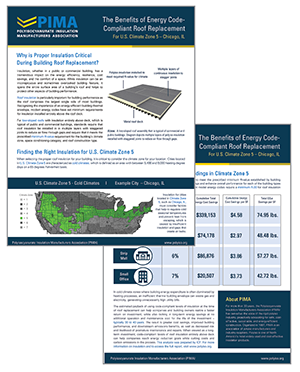Energy-efficient roof systems reduce costs, emissions

|
A new study from ICF International, a Fairfax, Va. based technology services and consulting firm, demonstrates code-compliant levels of roof insulation installed entirely above the roof deck as part of a roof system replacement project can help building owners achieve energy reduction goals while cutting costs and carbon emissions.
The study, commissioned by the Polyisocyanurate Insulation Manufacturers Association, quantifies the benefits of energy code-compliant roof system replacements in terms of energy and carbon emissions savings for common building types based on the U.S. Department of Energy prototype buildings: primary school, retail store, strip mall and small office. For the purposes of the study, the buildings were located in reference cities representing ASHRAE Climate Zones 2-6 for the U.S. and Canada per DOE’s methodology.
Specific findings from the study include:
- Roof system replacements are life-cycle economical under various conditions even when subjected to higher incremental installation costs and discount rates.
- Roof system replacements support the transition to building electrification through a significant reduction in natural gas fossil fuel use and overall improvement in energy efficiency.
- Roof system replacements support building performance standards and carbon emissions reduction goals by offering a cost-effective tool to help building owners reduce energy use and lower their carbon footprints.
For an existing roof system that requires replacement and contains insulation entirely above the roof deck, model energy codes and standards require the replacement roof system comply with minimum thermal envelope insulation levels. For buildings constructed before the widespread adoption of energy codes, energy-code compliant roof system replacements can significantly decrease whole-building energy use, reducing associated costs and carbon emissions.
“There are hundreds of millions of square feet of nonresidential, low-slope roofs across the U.S. and Canada, each with a limited life span and many are under insulated by today’s standards. Roof replacement offers a unique opportunity to cost-effectively improve overall building energy performance,” says Justin Koscher, president of PIMA. “The energy codes have improved over the past decade and require replacement roof systems to comply with minimum insulation levels. The ICF International study confirms that while there are costs to increase insulation levels, there also are tremendous benefits that extend for years and recapture the initial investment many times over.”
ASTM International signs memorandum with Mexico’s standards body

|
On Oct. 29, ASTM International and Mexico’s national standards body, Dirección General de Normas, signed a Memorandum of Understanding. Dirección General de Normas coordinates the development of standards and regulations and promotes standardization use in Mexico.
The Memorandum of Understanding serves as a cooperation agreement allowing ASTM International to continue its ongoing outreach to Mexico. ASTM International will continue to enhance communications to build government and industry awareness of ASTM International as a trusted technical source of information that supports public health and safety and the overall quality of life; encourages collaboration regarding topics of mutual interest; and promotes standards education and related activities for students and professors. In addition, Mexican stakeholders will be invited to help develop ASTM International standards to share knowledge and best practices, ensuring ASTM International standards meet and support Mexico’s local and global needs.
“To sign this Memorandum of Understanding is for us a historical moment,” says Alfonso Guati Rojo Sánchez, general director of standards in Mexico’s Ministry of Economy. “It’s relevant in the evolution of the processes of implementation of the quality infrastructure in Mexico. It’s important to set these kinds of agreements to disseminate and share information and train ourselves in the best way possible on high quality standards that are prepared around the world to be able to improve our systems.”
Construction industry data breaches increased 800% in one year
The 2021 Data Breach Outlook Study by Kroll, a New York-based risk consulting firm, shows the number of data breaches in the construction industry increased 800% from 2019 to 2020, according to forconstructionpros.com.
In recent years, the increase of new technologies and connections on job sites has made companies vulnerable to cyberattacks. At least 43% of those surveyed for the study believe they are ill-prepared for a breach.
Brian Lapidus, global practice leader for Kroll’s Identity Theft and Breach Notification practice, provides the following tips to help contractors keep their businesses safe:
- Have a cyberexpert and an attorney on retainer so you know who to call when a problem arises.
- Practice your company’s response to a cyberthreat the way schoolchildren and some businesses practice fire drills. For example, training exercises can include how to react to suspicious emails.
- Renew training periodically to improve employee responses to potential threats.
- Before a cyberbreach occurs, be sure you know where your company’s data—employee data, customer data, security data, proprietary data—is kept.
- Ensure someone on your team stays current regarding cybersecurity threats and technology.
- Encrypting data is a best practice within the cybersecurity industry, but it is not enough to protect a company. Lapidus recommends using a virtual private network as an additional layer of security.
- Monitor your networks to ensure all entry points are protected. Protecting entry points also helps inform a company about whether its network has been infiltrated by a cyberintruder.
- When contractors pay subcontractors and vendors, large amounts of money exchange hands. Your company needs to be sure such transfers are secure and safe from cyberthreats. For example, you can provide wire instructions and then force a phone call for a password or specific digits.
- Appoint someone at your company to oversee cybersecurity information and make decisions.
- If your company experiences a cybersecurity breach, it is important to communicate with and protect employees from any potential risk. Be cognizant of the effects a breach of data would have on your employees.



